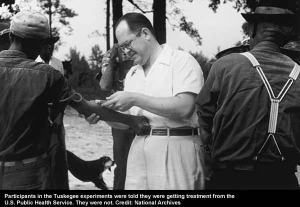The Tuskegee Experiment (From Truth-The Hemorrhage of Pigs!)
Tuskegee Syphilis Experiment
The Tuskegee syphilis experiment (also known as the Tuskegee syphilis study or Public Health Service syphilis study) was an infamous clinical study conducted between 1932 and 1972 in Tuskegee, Alabama by the U.S. Public Health Service to study the natural progression of untreated syphilis in poor, rural black men who thought they were receiving free health care from the U.S. government.
The Public Health Service, working with the Tuskegee Institute, began the study in 1932. Investigators enrolled in the study a total of 600 impoverished, African-American sharecroppers from Macon County, Alabama; 399 who had previously contracted syphilis before the study began, and 201 without the disease. For participating in the study, the men were given free medical care, meals, and free burial insurance. They were never told they had syphilis, nor were they ever treated for it. According to the Centers for Disease Control, the men were told they were being treated for “bad blood,” a local term used to describe several illnesses, including syphilis, anemia and fatigue.
The 40-year study was controversial for reasons related to ethical standards; primarily because researchers knowingly failed to treat patients appropriately after the 1940s validation of penicillin as an effective cure for the disease they were studying. Revelation of study failures by a whistleblower led to major changes in U.S. law and regulation on the protection of participants in clinical studies. Now studies require informed consent (with exceptions possible for U.S. Federal agencies which can be kept secret by Executive Order), communication of diagnosis, and accurate reporting of test results.
By 1947, penicillin had become the standard treatment for syphilis. Choices available to the doctors involved in the study might have included treating all syphilitic subjects and closing the study, or splitting off a control group for testing with penicillin. Instead, the Tuskegee scientists continued the study without treating any participants and withholding penicillin and information about it from the patients. In addition, scientists prevented participants from accessing syphilis treatment programs available to others in the area. The study continued, under numerous US Public Health Service supervisors, until 1972, when a leak to the press eventually resulted in its termination. The victims of the study included numerous men who died of syphilis, wives who contracted the disease, and children born with congenital syphilis.
The Tuskegee Syphilis Study, cited as “arguably the most infamous biomedical research study in U.S. history,” led to the 1979 Belmont Report and the establishment of the Office for Human Research Protections (OHRP). It also led to federal laws and regulations requiring Institutional Review Boards for the protection of human subjects in studies involving human subjects. The Office for Human Research Protections (OHRP) manages this responsibility within the US Department of Health and Human Services (HHS).
http://en.wikipedia.org/wiki/Tuskegee_syphilis_experiment
The Public Health Service Act of 1944 structured the United States Public Health Service (PHS) as the primary division of the Department of Health, Education and Welfare (HEW), which later became the United States Department of Health and Human Services. The PHS comprises all Agency Divisions of Health and Human Services and the Commissioned Corps. The Assistant Secretary for Health (ASH) oversees the PHS and the United States Public Health Service Commissioned Corps.
Mission
The mission of the U.S. Public Health Service Commissioned Corps is to protect, promote, and advance the health and safety of the United States. According to the PHSCC, this mission is achieved through rapid and effective response to public health needs, leadership and excellence in public health practices, and advancement of public health science.
Tuskegee Study of Untreated Syphilis in the Black Male
In 1932, the Public Health Service, working with the Tuskegee Institute, began a study to record the natural history of syphilis in hopes of justifying treatment programs for blacks. It was called the “Tuskegee Study of Untreated Syphilis in the Negro Male”.
The study initially involved 600 black men – 399 with syphilis, 201 who did not have the disease. The study was conducted without the benefit of patients’ informed consent. Researchers told the men they were being treated for “bad blood,” a local term used to describe several ailments, including syphilis, anemia, and fatigue. In truth, they did not receive the proper treatment needed to cure their illness. In exchange for taking part in the study, the men received free medical exams, free meals, and burial insurance. Although originally projected to last 6 months, the study actually went on for 40 years. It has been called “arguably the most infamous biomedical research study in U.S. history.”
Note that a USPHS physician who took part in the Tuskegee program, John Charles Cutler, was in charge of the US government’s syphilis experiments in Guatemala, in which Guatemalan prisoners, soldiers, orphaned children, and others were deliberately infected with syphilis and other sexually transmitted diseases from 1946-1948 in order to study the disease, in a project funded by a grant from the National Institutes of Health. President Obama apologized to Guatemala for this program in 2010.
http://en.wikipedia.org/wiki/U.S._Public_Health_Service
Diseases with which the CDC is involved in other than the Tuskegee Experiment is:
Influenza
The CDC has launched campaigns targeting the transmission of the flu, including the swine flu (H1N1). The CDC has launched websites including [flu.gov] to educate people.
Other infectious diseases
The CDC’s website (see below) has information on other infectious diseases, including smallpox, measles, and much more.
Non-infectious disease
The CDC also combats non-infectious diseases, including obesity.
http://www.cdc.gov/Features/Tuskegee/

